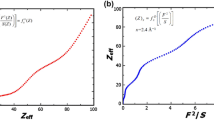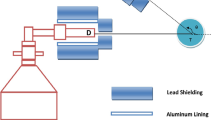Abstract.
The effective atomic number ( \( Z_{\rm eff}\) is a quantity which gives the fraction of the total number of electrons in a composite material participating in the photon-atom interaction. The effective atomic number has been determined for the materials of known composition by using different methods. However, no method has been reported so far to determine \( Z_{\rm eff}\) for thick samples of unknown composition. In view of this, we have evolved a simple method to determine the effective atomic number, which uses the scattering intensity ratios measured at two scattering angles, in which a sample of known \( Z_{\rm eff}\) or Z is taken as a reference sample. The values of \( Z_{\rm eff}\) obtained by this method agree with those obtained from the Auto-Zeff software within the stated errors. This method could be helpful in determining the effective atomic number of samples of unknown composition.
Similar content being viewed by others
References
G.J. Hine, Phys. Rev. 85, 725 (1952)
S. Prasanna Kumar, T.K. Umesh, Appl. Radiat. Isot. 68, 2443 (2010)
M.P. Singh, B.S. Sandhu, B. Singh, Nucl. Instrum. Methods Phys. Res., Sect. A 580, 50 (2007)
M. Donativi, S. Quarta, R. Cesareo, A. Castellano, Nucl. Instrum. Methods Phys. Res., Sect. B 264, 189 (2007)
P. Duvauchelle, G. Peix, D. Babot, Nucl. Instrum. Methods Phys. Res., Sect. B 155, 221 (1999)
V. Manjunathaguru, T.K. Umesh, J. Phys. B: At., Mol. Opt. Phys. 39, 3969 (2006)
R.S. Holt, M.J. Cooper, D.F. Jackson, Nucl. Instrum. Methods Phys. Res. 221, 98 (1984)
P. Duvauchelle, G. Peix, D. Babot, NDT & E Int. 33, 23 (2000)
M.V. Manjunatha, B.M. Sankarshan, T.K. Umesh, X-Ray Spectrom. 43, 246 (2014)
L. Vinaykumar, T.K. Umesh, Appl. Radiat. Isot. 103, 100 (2015)
J.H. Hubbell, Wm.J. Veigele, E.A. Briggs, R.T. Brown, D.T. Cromer, R.J. Howenon, J. Phys. Chem. Ref. Data 4, 471 (1975)
J.H. Hubbell, M.J. Berger, M. Leimdörfer, Photon attenuation, in Engineering Compendium on Radiation Shielding, edited by R.G. Jaeger (Springer, 1968) pp. 167--258
M.L. Taylor1, R.L. Smith, F. Dossing, R.D. Franich, Med. Phys. 39, 1769 (2012)
S. Manninen, S. Koikkalainen, Int. J. Appl. Radiat. Isot. 35, 965 (1984)
M.P. Singh, A. Sharma, Bhajan Singh, B.S. Sandhu, Nucl. Instrum. Methods Phys. Res., Sect. A 619, 63 (2010)
Author information
Authors and Affiliations
Corresponding author
Rights and permissions
About this article
Cite this article
Sankarshan, B.M., Athrey, C.D. & Umesh, T.K. Determination of the effective atomic number of thick samples of unknown composition using scattering studies. Eur. Phys. J. Plus 132, 271 (2017). https://doi.org/10.1140/epjp/i2017-11553-2
Received:
Accepted:
Published:
DOI: https://doi.org/10.1140/epjp/i2017-11553-2




